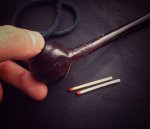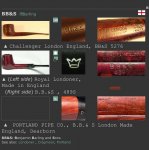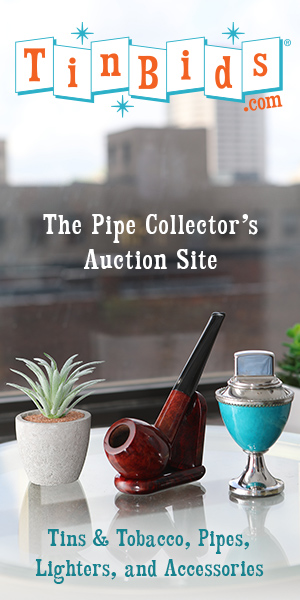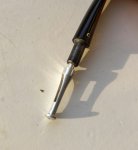Hi everyone!
There is a recent addition to my collection. I saw this little Prince (group 2 or 3 I'd say) on eBay with a pretty low buy-it-now-option. The pictures were telling me chances are good that this is a very harmonic Prince shape, which is quite rare in my eyes. So without a second thought I pulled the trigger. And I did right so! This piece came in as a NOS, and I'm assuming it is a Barling 2nd from the pre-transition era, the (late) 50ies or so.
The pipe is crafted really nicely, it even got away with a decent blast. Especially the delicate curve of the stem that is so important for the shape turned out wonderfully and even forms a unit with the shank. The bit is very thin and comfortable.
What I'm asking myself now as someone who doesn't know all too much about Barling pipes: might this really be a Barling 2nd from the pre-transition era? I have attached a screenshot from the pipephil page showing some other BBS examples. They all have a "BB&S" stamp instead of the "B.B.S" on my Prince. Plus, and this makes me wonder about the pre- or post-transition question: they all have 4-digit shape numbers, my Prince has a 3-digit shape number, the 204. In the back of my mind there is the info, that 1-, 2- or 3-digit shape numbers were used in the pre-transition era. Is this or might this also be true for Barling 2nds?
And: I believe I somewhere in the www had seen a shape chart for pre-transition Barling pipes. For those that had a 1-, 2- or 3-digit shape number. Does anyone know of such a shape chart or is my memory playing tricks on me?
Here are some pictures:



Cheers everyone, have a good week! And thank you for your help!
Eddy
There is a recent addition to my collection. I saw this little Prince (group 2 or 3 I'd say) on eBay with a pretty low buy-it-now-option. The pictures were telling me chances are good that this is a very harmonic Prince shape, which is quite rare in my eyes. So without a second thought I pulled the trigger. And I did right so! This piece came in as a NOS, and I'm assuming it is a Barling 2nd from the pre-transition era, the (late) 50ies or so.
The pipe is crafted really nicely, it even got away with a decent blast. Especially the delicate curve of the stem that is so important for the shape turned out wonderfully and even forms a unit with the shank. The bit is very thin and comfortable.
What I'm asking myself now as someone who doesn't know all too much about Barling pipes: might this really be a Barling 2nd from the pre-transition era? I have attached a screenshot from the pipephil page showing some other BBS examples. They all have a "BB&S" stamp instead of the "B.B.S" on my Prince. Plus, and this makes me wonder about the pre- or post-transition question: they all have 4-digit shape numbers, my Prince has a 3-digit shape number, the 204. In the back of my mind there is the info, that 1-, 2- or 3-digit shape numbers were used in the pre-transition era. Is this or might this also be true for Barling 2nds?
And: I believe I somewhere in the www had seen a shape chart for pre-transition Barling pipes. For those that had a 1-, 2- or 3-digit shape number. Does anyone know of such a shape chart or is my memory playing tricks on me?
Here are some pictures:



Cheers everyone, have a good week! And thank you for your help!
Eddy
Last edited:












